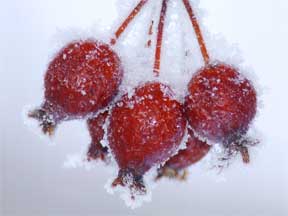“What has been – will be.” This classic statement has been passes down from generation to generation. The existence of irregular fluctuations in weather of sufficient severity to cause severe damage to commercial fruit trees and buds has long been confirmed. These can take many forms, such as:
- Severe winters of protracted cold
- Early fall freezes before the trees reach maturity
- Late spring freezes following warm winters
- Quick thawing of frozen trees from reflected light off the snow occurring at the two o’clock spot
- Spring frosts
- Excessive rainfall in late summer and fall which delays maturity of the trees
- Severe drought
- Etc.

It is interesting to speculate when this damage is likely to occur. I remember my grandfather telling me of the winters of protracted cold in the Midwest occurring at intervals of approximately 19 years – 1865, 1885, 1899, 1918, and 1936. So we must always ask – “Are we overdue for another?”
Throughout many sections of the Midwest in when rainfall was the highest ever recorded. The first killing frost did not occur until early November and many of the leaves were still on the trees on November 24. The Thanksgiving Day freeze of 1950 was long be remembered by old-timers throughout the Midwest as killing and damaging more trees than any other freeze in their memory.
Michigan fruit growers never forgot the October 11 and 12, 1906 freeze. They had had a similar experience in l869. Yet can we say that fruit growers can expect one of these disastrous fall seasons at intervals of approximately 40 years?
Much evidence could be assembled to either prove or disprove this contention. Spring freezes have occurred in many sections on many occasions. There is no pattern that can be found to predict the years in which freezes will occur.
Over 100 years ago the grape industry was of major importance in the bluegrass section of Kentucky. On May 1, 1862 a devastating frost killed every vineyard in the area. The Civil War was on and tobacco was just coming into prominence, so the grape industry was never reestablished in that area.
From the record, it should be clear that tragedy is most likely to hit at least once in the life of any block of fruit trees. We should be concerned with what can be done to mitigate the damage.
The first consideration is to go into the commercial business in a weather proven region. The second is to select a good site with proper drainage, avoiding low areas where lowest temperatures occur.
Checking the area on critical nights with recording thermometers before planting will yield vital information.
The greatest destruction that has occurred in many orchards has been done in years when heavy rainfall has induced late growth and low winter temperatures have followed.
While it is not possible to avoid all injury to trees and buds during certain years and in certain combination of weather conditions, there is much the fruit grower can do.
However, the memory of man is short. As the memory of destructive winters or early and late freezes recedes, there is always negligence in applying corrective measures to meet possible future disaster.
Is Our Weather Changing?
Many persons and the media say the weather has changed in the past 50 or 100 years. However, they never agree which way it has changed. About as many think our winters are less severe as think they are more severe. There is ample evidence that our weather is relatively constant. That there is a wide variation within certain periods, of prolonged, severe cold, early freezes, late frosts, and wet and dry seasons is abundantly proven within the record of peach production in the past 100 years. ”
Black Friday, February 7, 1807, when the cold was so sudden and so severe even the forest trees split open with resounding noise will return again!
